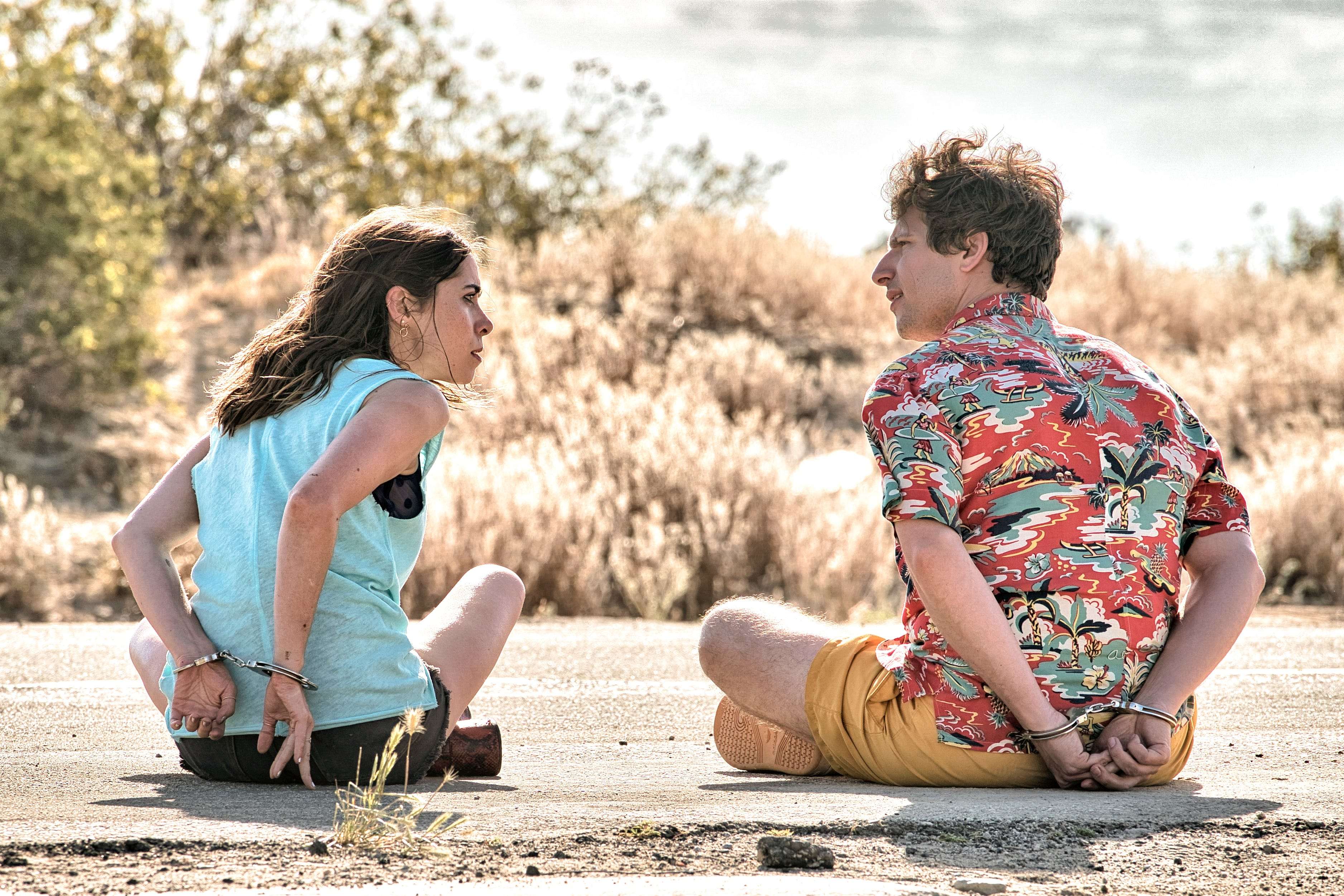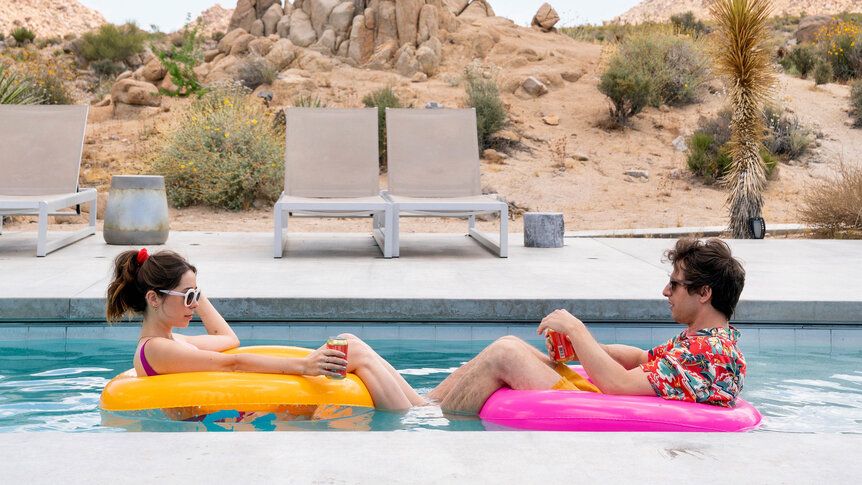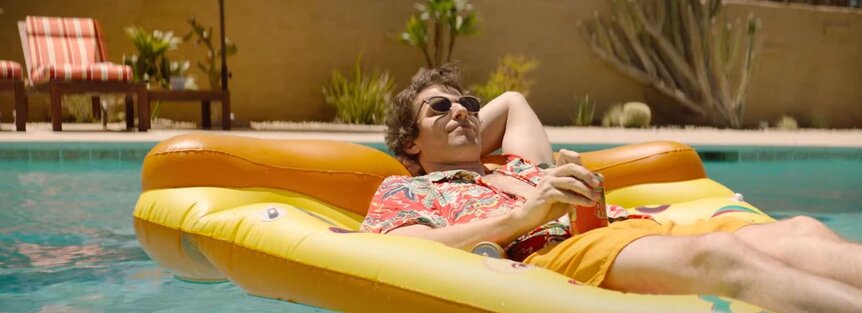Create a free profile to get unlimited access to exclusive videos, sweepstakes, and more!
Palm Springs' loopy ending doesn't change what it's ultimately about, writer says

At one point in Palm Springs, a new movie streaming on Hulu, Andy Samberg’s character, Nyles, helpfully explains to Cristin Milioti’s Sarah why they find themselves trapped in a single day that never ends. It’s "one of those infinite time-loop situations that you might have heard of,” Samberg says offhandedly. “Loop” movies, of which Palm Springs is a fine example, owe much (if not everything) to 1993's Groundhog Day, which turned the idea of being caught in a loop in Punxsutawney, Pennsylvania, into a comedy classic. Once you look around, you start noticing “loop” stories all over the place: Edge of Tomorrow, Before I Fall, Happy Death Day, Russian Doll — the list goes on.
By now we should know what to expect from this genre, right? But Palm Springs screenwriter Andy Siara had something else in mind. His loopy new movie is a genre-bending rom-com that embraces both the cynicism and the hope that many people feel about the institution of romance.
SYFY WIRE caught up with Siara to chat about Palm Springs (and our conversation only happened the one time. No loops!).
**SPOILER ALERT: This interview contains spoilers for Palm Springs.**
How did you decide you wanted to freshen up the Groundhog Day-style "infinite time loop"? Did you look at other time-loop movies? Did you figure out what variables could be tweaked to change the equation? Did you consider, for example, Danny Rubin’s original draft for Groundhog Day, where it started in medias res, instead of the beginning, and includes the love interest in the time loop, since yours does both?
No. I didn’t know that! I hadn’t read the original script. But that’s kind of refreshing to hear, because that movie provided an architecture that is now part of the language of film. This movie didn’t start as a time-loop movie, or a wedding movie, or a rom-com. Five years ago, the director [Max Barbakow] and I left film school, and we wanted to make our first movie together, and the idea was something that could be contained in a weekend. We went out to Palm Springs and had a soul-searching weekend, and when we left, we realized it should be set in Palm Springs. We both had been to several weddings out there, but we hadn’t thought about setting the movie at a wedding yet.
We had an idea for this character who is a nihilist named Nyles, and then everything formed around this character. During that time and over the next couple of years, I got married and had the wedding in Palm Springs. Going through my own existential crisis, and Max going through his own existential crisis, helped me find the story. It was just letting the character lead the way. It was a weird process of discovery. And after a certain point where both of our own lives had started feeling kind of meaningless in a way, where every day starts to feel the same — going to the same job, eating the same things every day — was when we thought, “Should we just do a time-loop thing?” Because I was already kind of drifting in that direction in the writing of it. So we were like, “Yeah, let’s do that.”
But to separate ourselves from Groundhog Day, which is one of the greatest movies ever made, one of the greatest scripts ever written, I was thinking, “OK, at the end of Groundhog Day, Bill Murray’s character kind of figures out the meaning of life, or what he thinks the meaning of life is, and the loop breaks.” That was the jumping-off point for me. This guy Nyles figures out the meaning of life, or what he thinks the meaning of life is, but the loop doesn’t break. He’s truly stuck there for eternity. So now what can you do? Can you actually find meaning in the meaningless? For him, that becomes Doritos, beer, and swimming in a swimming pool, basking in the love of life, embracing the mundane. I don’t even want to call it a twist, but that entry point made this movie kind of a sequel to a movie that doesn’t exist. There is a whole other movie out there about when Nyles first got stuck in this time loop, but that idea is already well-explored ground, and has been done far better than I could do it. What we can do is a slightly fresh take on it. And that started as we were way deep into it.
Then these other characters come in, who also get stuck in the loop, not as a way to distinguish it from Groundhog Day, but because that’s what the story we were trying to tell needed. It needed the Sarah character there. It needed the Roy character there. And it was a nice benefit that it became a point of separation from Groundhog Day as well.
In one of your earlier drafts, you went deeper into the quantum mechanics of time loops, via Sarah’s research into black holes, cosmology, magnetic vortexes, parallel universes, and quantum suicide. Did you tighten that for comedy’s sake?
In the first draft, I was taking more of a Jungian approach to the whole movie and just saying that the main rule is that there was no way out of the time loop, and then building the story off of that. Then once Lonely Island came on board as producers, we developed the script further, and they encouraged us to think, “What if they try to find a way out? How do we do this?” That was one of Andy Samberg’s first pitches to us, which became the ending with the cave.
And that was nice, because there was an earlier version of the script where I toyed with the idea of walking into that cave. I think I was too scared to do that. I don’t even know why. So it got cut, and then when Andy pitched that, we brought it back in, to try to find the science behind it. I went down a rabbit hole of YouTube videos about black holes, string theory, the Cauchy horizon, all of that. If an astrophysicist saw Palm Springs, he would say I’m an idiot! [Laughs.]
It at least makes a tiny bit of sense? We checked with one physicist [Clifford V. Johnson], who was like, “There is a world where this might be an explanation for how they get out,” so it’s worth a try.
When Sarah goes down that same rabbit hole, it’s using our time loop to our advantage, in the same way a robot who has access to the Internet in a modern-day A.I. movie could say, “Hold on, let me learn how to fly an airplane,” look it up, and come back a second later and be like, “I know how to fly an airplane.” That’s the same idea. Learning about black holes and quantum theory would take an endless amount of time, and we condense it to like a minute of montage. But in her reality, she spent perhaps years going down that rabbit hole.
So if Andy Samberg suggested that they find a way out of the time loop, to end the movie, what was your original ending like? Beyond not getting out of the loop?
The absurd speech was always there. “What if we get sick of each other?” “We’re already sick of each other. It’s the best.” “I can survive just fine without you. But there’s a chance life can be a little less mundane with you in it.” They kind of accept that this is what it is, and they make a different kind of leap together. Like, “We might as well try to share this experience.”
I mean, it’s weird, because changing the ending fundamentally changed some aspects of the story, but I still think by that point in the movie, it’s almost like everything else is just icing on the cake — the kiss, the explosion, the floating in the pool. As long as these characters get to that moment where they realize they both need to take this leap.
So it doesn’t change the metaphor about long-term commitment. What was it like finding the right tone for a romance about people who are cynical about romance?
I feel like I understand both sides of that argument, the romantic and the anti-romantic. A lot of this is my own grappling with marriage. My parents are happily married. I am happily married. I got married during the writing of this. But am I happily married because I saw the example of my parents? If they had gotten separated, would that change how I fundamentally look at marriage? I have friends who are like, “We’ll never get married,” and friends who are married to their high school sweethearts.
Is there a right way to go about it? I don’t think so. It’s just whatever works. And I was trying to take both sides, arguing for both sides throughout the movie.
We don’t usually get that in time-loop stories. Either the characters are destined to be together, or they’re too cynical to even consider it as an option, like in Russian Doll. Their partnership is limited to solving the puzzle.
Yeah. Another one of the important parts of the movie is the campfire scene, where you have two people who did not believe themselves capable of falling in love, because of their emotional baggage, or because nothing matters, or because they didn’t think love was possible, they actually start to realize that their outlook was slightly wrong. And they fall in love at that moment. They see the impossible.
How did writing this movie help you and your significant other decide to get married?
We were already together and engaged about a month before I started writing. I told my wife after the premiere, “You know this film is all about us, right?” That was my approach to it. I told the story of my own relationship.
But at the same time, this not just my movie. Everyone else can bring their own thing to it. And Max, the director, is the other, crucial side of the coin. I had already done that very terrifying thing of getting engaged, and getting married, and Max was on the other side during the writing of this. He was in different types of relationships, he was not happy, and maybe this movie helped him see that a bit more clearly. And he happened to fall in love during the making of this, and two or three months ago, he asked his girlfriend to marry him!
Palm Springs is now available on Hulu.
















